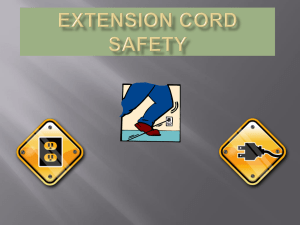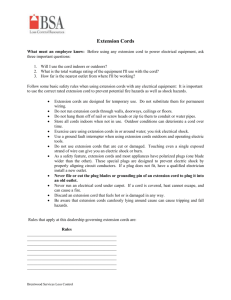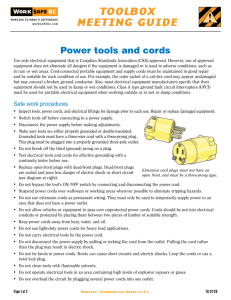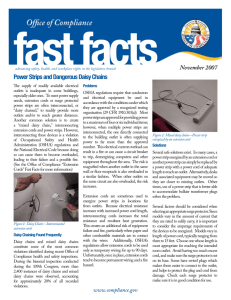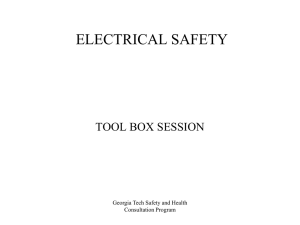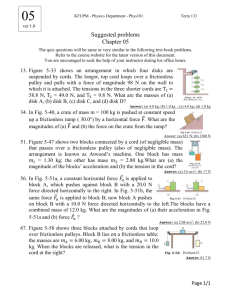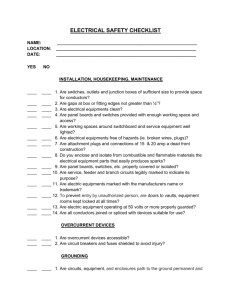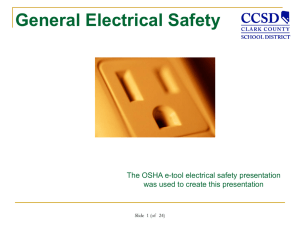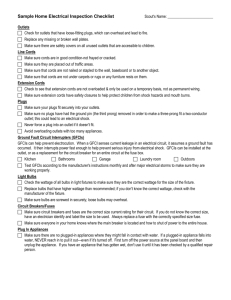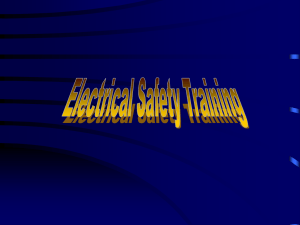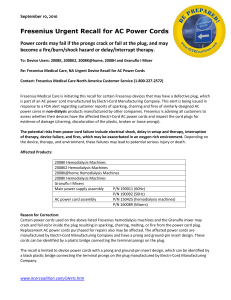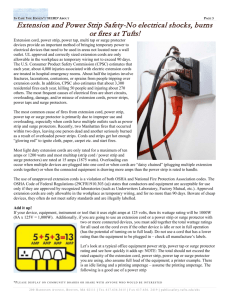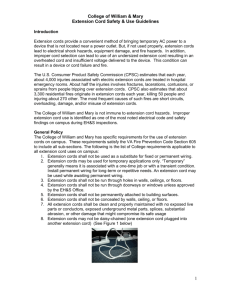Extension Cords Policies and Procedures
advertisement
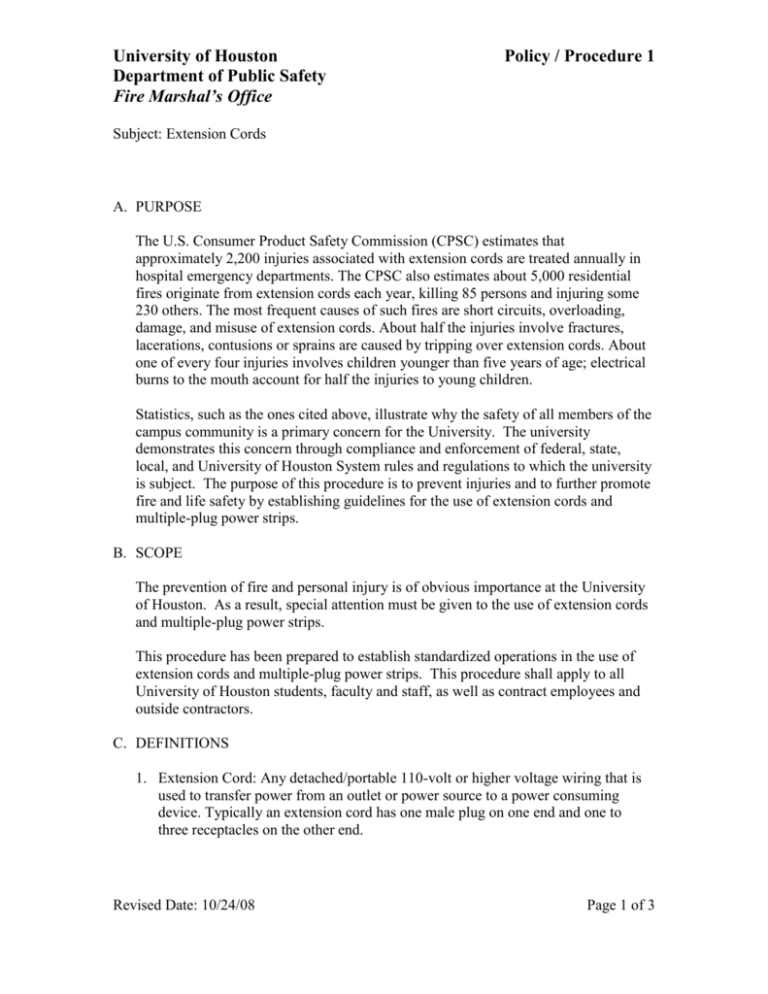
University of Houston Department of Public Safety Fire Marshal’s Office Policy / Procedure 1 Subject: Extension Cords A. PURPOSE The U.S. Consumer Product Safety Commission (CPSC) estimates that approximately 2,200 injuries associated with extension cords are treated annually in hospital emergency departments. The CPSC also estimates about 5,000 residential fires originate from extension cords each year, killing 85 persons and injuring some 230 others. The most frequent causes of such fires are short circuits, overloading, damage, and misuse of extension cords. About half the injuries involve fractures, lacerations, contusions or sprains are caused by tripping over extension cords. About one of every four injuries involves children younger than five years of age; electrical burns to the mouth account for half the injuries to young children. Statistics, such as the ones cited above, illustrate why the safety of all members of the campus community is a primary concern for the University. The university demonstrates this concern through compliance and enforcement of federal, state, local, and University of Houston System rules and regulations to which the university is subject. The purpose of this procedure is to prevent injuries and to further promote fire and life safety by establishing guidelines for the use of extension cords and multiple-plug power strips. B. SCOPE The prevention of fire and personal injury is of obvious importance at the University of Houston. As a result, special attention must be given to the use of extension cords and multiple-plug power strips. This procedure has been prepared to establish standardized operations in the use of extension cords and multiple-plug power strips. This procedure shall apply to all University of Houston students, faculty and staff, as well as contract employees and outside contractors. C. DEFINITIONS 1. Extension Cord: Any detached/portable 110-volt or higher voltage wiring that is used to transfer power from an outlet or power source to a power consuming device. Typically an extension cord has one male plug on one end and one to three receptacles on the other end. Revised Date: 10/24/08 Page 1 of 3 Subject: Extension Cords Policy / Procedure 1 ________________________________________________________________________ 2. GFCI- (Ground Fault Circuit Interrupter): Instantly disconnects power-thereby preventing electric shock and fires. These devices interrupt the circuit to the load when a fault current to ground exceeds a predetermined value that is less than that required to operate the over-current protective device of the supply circuit. 3. Multi-plug power strip: Outlet cases house multiple grounded outlets, circuit breakers and cord assembly in one unit. Allows for power control on the strip as well. 4. Piggy-backing: Attaching one extension cord or power strip to another extension cord or power strip to add length 5. Permanent Wiring: Wiring that is used for more than 8 hours in a day and is left connected at all times. 6. Temporary-Use: Use in remote locations for short time periods such as in maintenance procedures (vacuum cleaners), construction (hand-held power tools), or classroom instruction (portable computers or audio-visual equipment). D. PROCEDURE 1. Extension cords shall not be used as a substitute for permanent wiring. Where possible, additional electrical circuits and outlets shall be added to permit appliances to be plugged directly into an outlet. 2. Multiple-plug adapters (octopus adapters) are not permitted. 3. Multiple-plug Power Strips: a. In cases where inadequate outlets are available, multiple-plug power strips that are fused for the wire size of the connecting cord are allowed. However, only power strips with integral circuit breakers shall be used. b. Where multi-plug power strips are used, they shall be plugged directly into a wall outlet and may not be used in combination with extension cords. c. Where multiple-plug power strips are used they may not be connected to outlets of other power strips (piggy-backed). 4. Temporary-use extension cord construction, use and maintenance: a. Flexible extension cords shall contain a ground wire and shall be constructed from type S, hard usage material. When cords are used with heating appliances, a type HS cord is required. Revised Date: 10/24/08 Page 2 of 3 Subject: Extension Cords Policy / Procedure 1 ________________________________________________________________________ b. A minimum of 14 gage wire is required in a flexible cord servicing a current draw of more than 7 amps. c. All flexible cords must by U.L. listed. d. Extension cords shall not be used on stationary equipment or equipment drawing more than 15 amps, such as refrigerators, centrifuges, or power tools. e. Extension cords shall not run through, behind or in walls, ceilings or floors or other concealed space. Nor shall they be run in or through ventilation ducts. f. Extension cords should not be placed under carpets, under doors, or other locations that subject the cord to abrasion or other damage. g. Extension cords should not be placed in walkways where possible. Cord covers may be used if necessary to place the cord in a walkway. h. Discard extension cords with broken wires or damaged insulation; splicing or taping is not allowed. i. Where hazardous atmospheres may exist, due to the presence of flammable gases or vapors or explosive dusts, extension cords shall not be used. j. The combined length of the appliance cord and extension cord that is used on very portable equipment, such a floor scrubber, projectors and hand tools, shall not exceed 105 feet. k. GFCI devices shall be used outdoors, within six foot of a water source, and in damp/wet locations. 5. Temporary-use extension cord general safety considerations: a. Uncoil long cords, when in use, to avoid overheating. b. Replace short appliance cord with a longer one when appropriate. c. Consider the proximity of electrical outlets when locating furniture. d. Select a cord with proper insulating materials if there will be exposure to moisture, oil or other chemicals. e. Frequently check the cord insulation, plug and connector for damage. Revised Date: 10/24/08 Page 3 of 3
